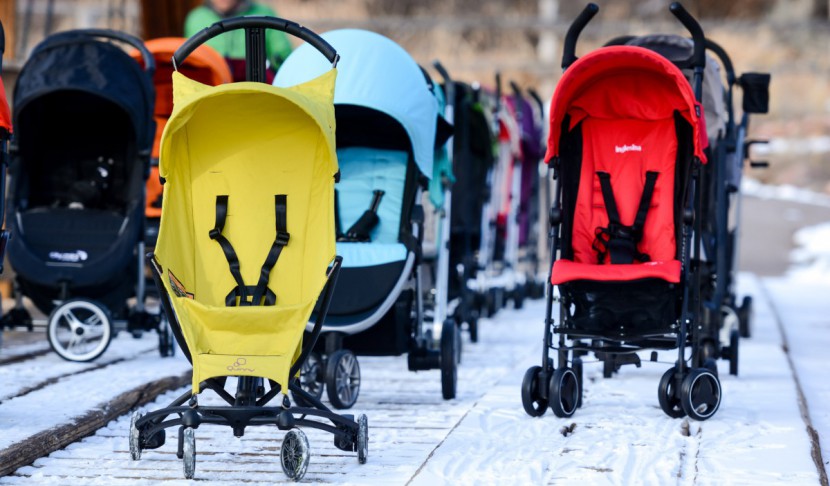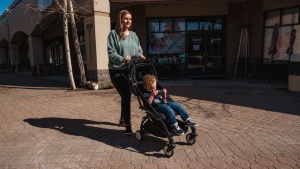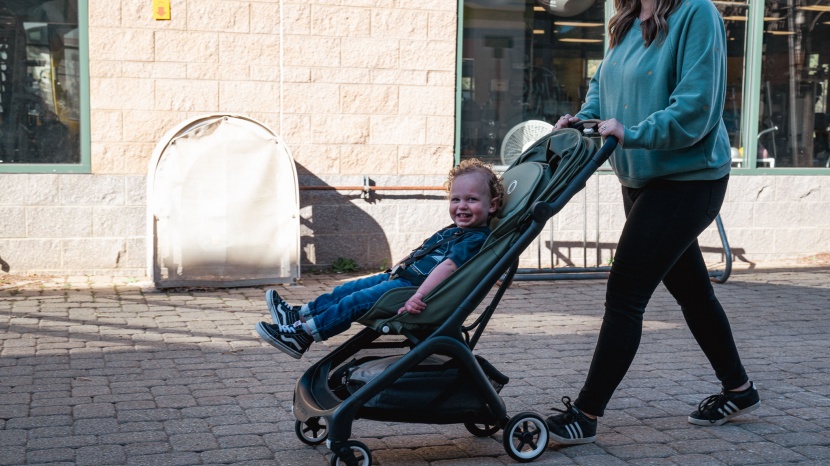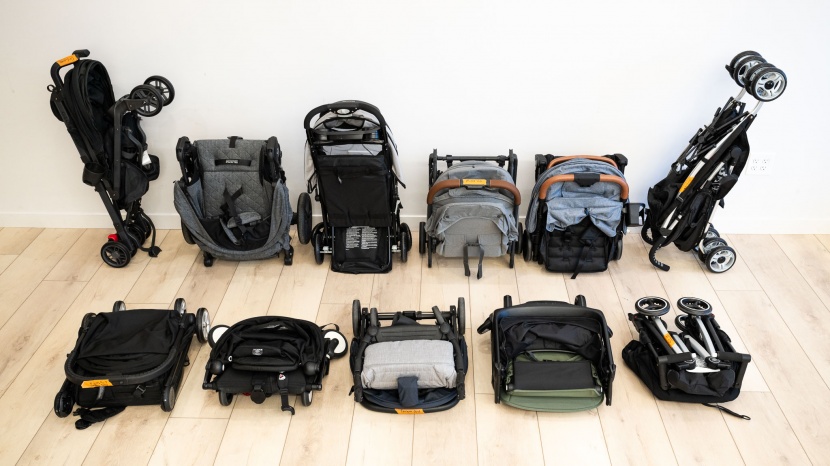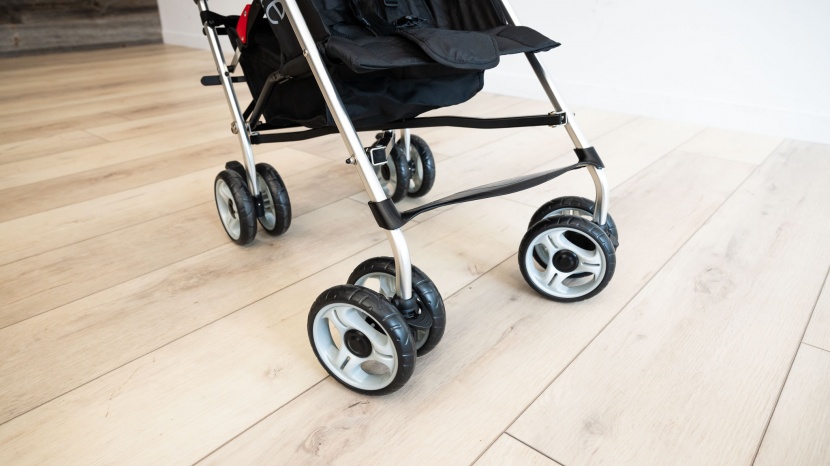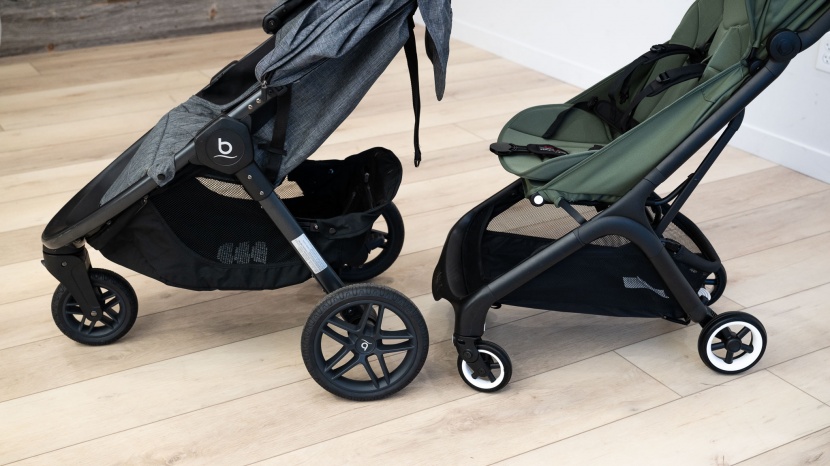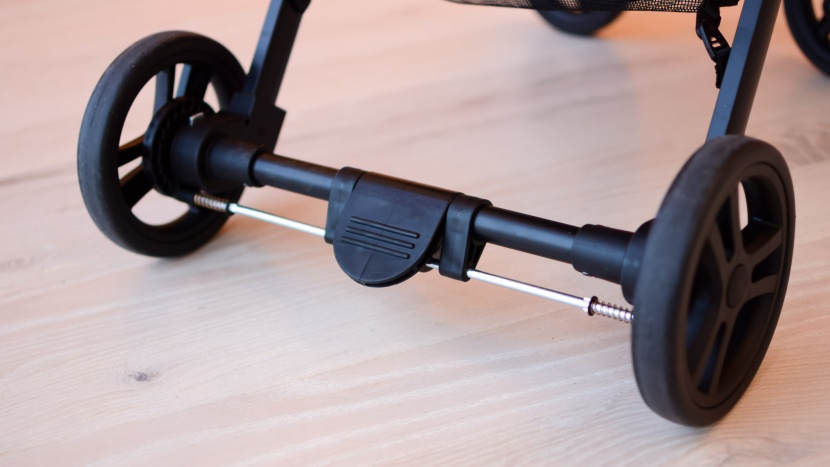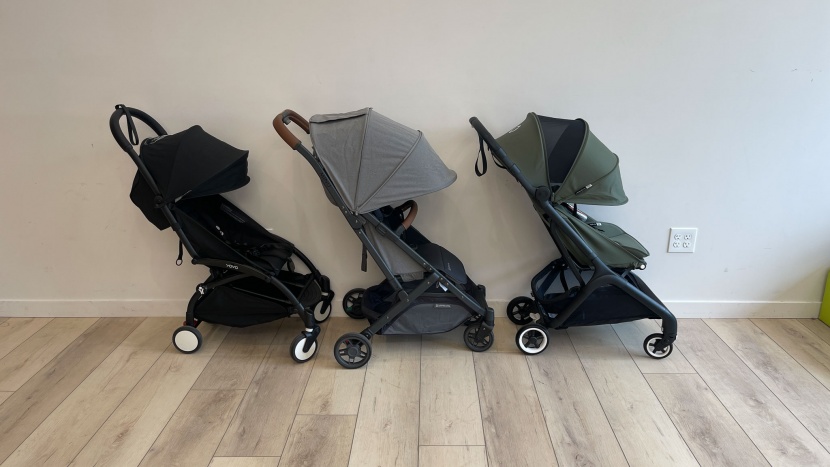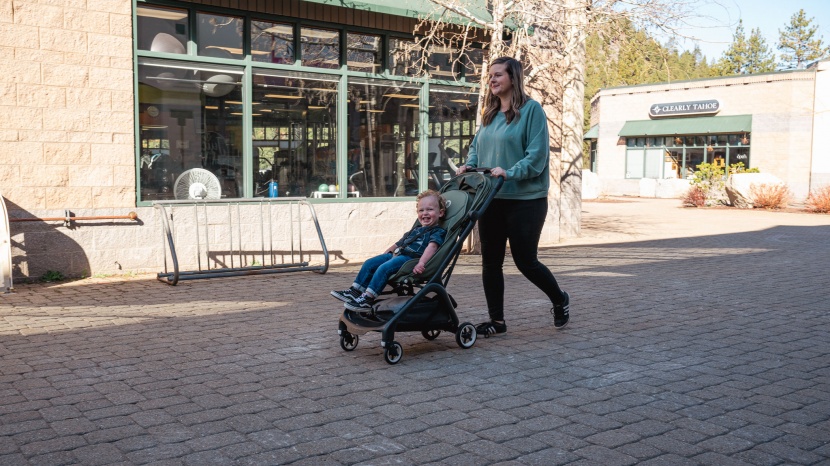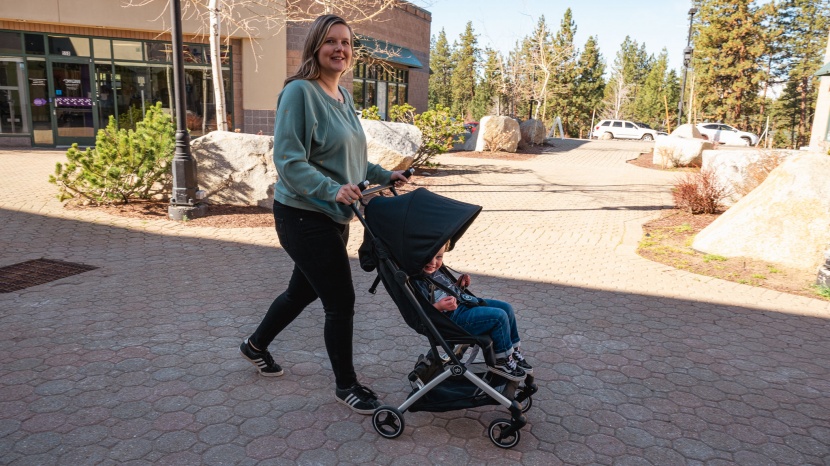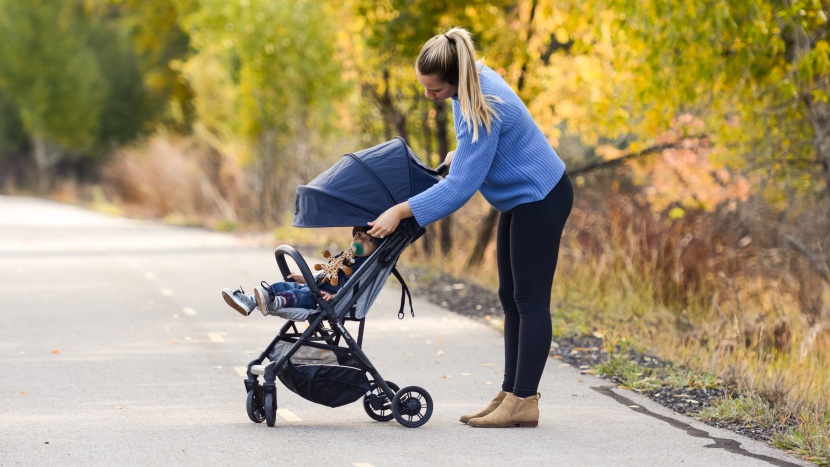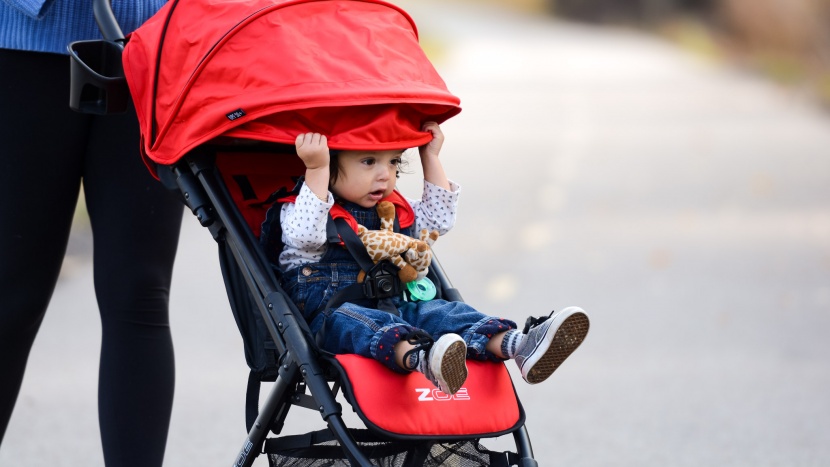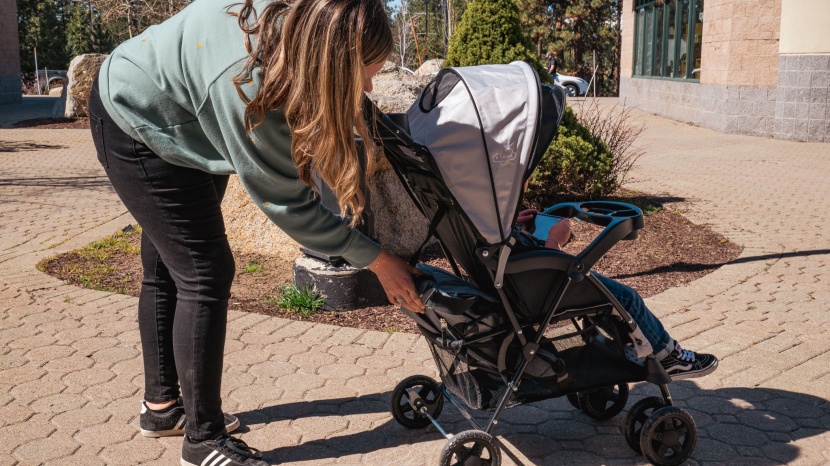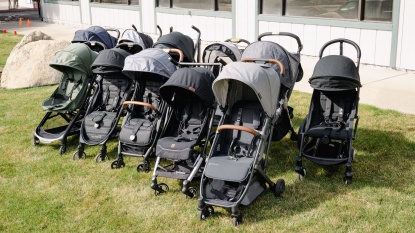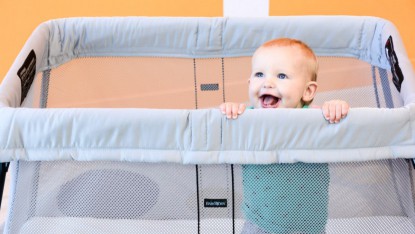After months of use, and extensive testing, we have all the information you need to determine which lightweight or top-ranked travel stroller is the right one for you. This article will share what we learned and give you a better idea of what you might consider before purchasing your own. If you are unsure if a lightweight stroller is the right style for you, it may help to look at different stroller styles before making your final decision.
Why Buy a Travel Stroller?
This type of stroller is usually a secondary product in addition to a favorite full-size stroller or a top-ranked jogging stroller. Most parents look to a travel stroller when they need a simple, compact stroller for travel or commuting when a standard stroller's size and weight won't work. These products are smaller than other strollers, easier to fold and carry, and relatively lightweight. Some of these products collapse in on themselves like an umbrella, while others fold in half or thirds, which often makes a more compact package for easier storage in smaller spaces.
In general, this kind of stroller lacks the features of a standard model, which results in a lighter, more compact stroller that is not off-road friendly. They are intended primarily for flat surfaces without many obstacles. Most parents purchase this kind of stroller for travel, grandparents, or quick day trip commuting.
The new generation of lightweight strollers has come a long way from the umbrella strollers of yore. Some offer enough features that you might be able to get by using one as a primary stroller. This is especially true if you use an infant car seat carrier and a top-ranked baby carrier when children are too small to ride in most lightweight strollers. With their storage bins, reclining seats, sun shades, and leg rest, some of the strollers we reviewed can do double duty for parents looking to pare down their purchases, retain space in their homes, or save money.
Types of Travel Strollers
There are two types of strollers in this category. There is the traditional umbrella, which most parents have in mind when looking for a compact stroller for travel, and travel models that are smaller than a traditional stroller but different than an umbrella.
An umbrella stroller is small, easy to fold, compact, and easy to transport. These strollers usually have no special features or convenience items, and their primary nod to comfort is a (typically small) canopy. The upside to this type is that they are easy to use and transport virtually anywhere with ease. The BabyZen Yoyo2 is an excellent example of this type. It has a smaller sunshade, limited storage, and folds simply into a compact package that can be easily carried. However, many umbrella style options lack features which makes them less versatile than those with more conveniences. It could be challenging to take longer trips without the storage and comfort that a larger version usually has.
The lightweight travel options are usually lighter than a full-size stroller but offer more than the umbrella style for convenience and comfort. Many of these products include under-seat storage bins, larger canopies with peek-a-boo windows, reclining back pads, adjustable leg rests, and cup holders. These strollers offer more features for comfort and convenience, and some might even be good candidates for the only stroller in a household. These products retain the simplicity of a basic umbrella because they still offer a compact fold, lightweight design and are easier to transport than their larger standard cousins. Some also provide self-standing and auto-locking features that allow a one-hand fold and easy commuting. These products can provide the best of both worlds, riding the fine line between a simple umbrella and a standard-sized product.
In this review, we include the Britax B-Free as it is relatively lightweight and folds small. While not technically a lightweight stroller, it could do double duty, depending on your needs.
Performance Considerations
We tested and ranked the products in our travel stroller review, but it makes sense to say a little about the performance considerations of how these strollers work and what you should look for when choosing. Our review and tests are designed to illuminate the differences, and this information can be a tool for sorting and narrowing the field.
The performance of each product and its features vary. Still, we found consistencies and commonalities that you'll want to consider, even if they aren't covered in our review.
Size Matters
Size doesn't always matter, but when it comes to travel strollers, it is an essential factor for performance and a primary goal for this type of gear. This kind of stroller was initially created because of a size issue. Parents were looking for a small, lightweight, compact stroller that could easily fold, carry, store, and lift. Size can influence the overall experience of the user and passenger. If a lightweight stroller is too big, it fails to meet the user's needs, and you won't want to use it for travel. If a model is too small, the passenger might find it uncomfortable.
The products we considered range from 10 to just over 22 lbs. This range is pretty wide. Ten plus extra pounds can be a lot of weight, and if you are carrying a child or other items in addition to the stroller, it could be a deal-breaker. If the stroller is not small enough, it doesn't fill the need; if it is too small, it may not be convenient. Much like in Goldilocks and The Three Bears, the real issue is finding the model that is just the right size for you.
How Many Wheels?
One thing that is more common in traditional strollers in this category is the dual front wheel design. This design has two front wheels on each front leg. Most models that share this design performed poorly in our maneuverability tests. The dual front wheel design has trouble with terrain changes, veering off-course for random bumps and getting stuck in deeper gravel or grass. The products that performed the best in maneuverability did not have this design, so we are at a loss as to why it seems so common. Some others have single wheels on each leg. These products earn higher scores for maneuverability and indicate that the dual-wheel design should give you pause.
In general, it appears as though performance increases when the number of wheels decreases. While it may not be accurate for each model, it is true for this kind of gear, so it is worth some consideration when looking at options.
Brakes
Each stroller has some braking mechanism, many of which are similar in design—weeding out which is which or what to look for can be difficult. We discussed factors like ease of use and foot friendliness. However, given the importance of this topic, it still merits a mention in the performance consideration section when sorting through strollers and deciding what to buy.
Generally, strollers with a single action are the easiest to use. Models requiring two different pedals, or double action, might suffer from user error over time as parents become complacent and fail to engage both brakes. The products with one pedal to engage and one to disengage, sometimes with a color code or illustration to differentiate one from the other, are simpler and easier to use.
While we would all like to believe that everyone will religiously set brakes on any stroller their child is a passenger in, we also can't argue with the notion that if something is difficult to use, people may refrain from using it. If it is easier to use, the bottom line is you will be more likely to use it and use it correctly. All the brakes in our tests worked, however, the method for using them is different, and thus the resulting compliance is also likely to be different. Pressing one pedal is more straightforward than two, pressing a separate pedal to disengage is easier than lifting a pedal with the top of your foot, and so on. The brakes that get used are the straightforward ones that you operate quickly. It doesn't matter how fantastic a brake system is; it can't do its job if it doesn't get used.
Versatility
Whether or not the stroller you purchase is easy to use and meets your needs is a significant performance consideration. Just because a stroller has the features you are looking for doesn't mean it does them well. Every model in our review came with a sunshade, but not all the shades are UPF-rated or even big enough to protect smaller riders. Some attach to the backrest and give side protection, while others are more or less an overhead feature, letting the sun in the sides. Features must work the way the maker and user intend; otherwise, there is little point in having them except to check the box in a comparison chart.
You should definitely consider using asunscreen for baby if your sunshade is small or you'll be outdoors for prolonged periods.
Many features can impact the versatility of the item. Having multiple features can be a plus, if the features work well and are thoughtfully designed. It isn't enough to count the number or types of features; instead, you should consider if the features work correctly and add versatility. If these things aren't true, the feature might look good on paper but cause real-life frustration.
Narrowing the Field
When you add a lightweight stroller to your baby gear, we suggest you narrow the options by first looking at the following considerations.
Location, Location, Location
First, consider where you plan to use your lightweight stroller. Will it be a city dweller used primarily in the concrete jungle? Or will you push it across a green belt and go to the park? Are you looking for a stroller to get through the airport, or will you try to survive the Sunday rush at the zoo? How you intend to use the stroller, what locations you will frequent, and the kind of ground you will cover should influence which stroller you decide to buy.
If you live in the city and need an agile stroller for getting places quickly and convenient folding for public transport, then a more compact stroller with fewer features is the right fit. The Inglesina Quid or BabyZen Yoyo2 can be carried hands-free, are light enough to lug for miles, and fold easily. However, if you envision using your stroller for a day at the park and a quick trip to the farmers market, then the Quid is unlikely to offer enough features or comfort, and the Yoyo2 might be a better fit.
Knowing how you will use the stroller can be the difference between finding a fantastic product that fails to meet your needs and buying a “just the right size” fit. There is no one perfect answer to this question; it is just a personal answer. Don't be taken in or wooed by a flashy design or extraordinary engineering; you'll be unhappy if the stroller doesn't meet your needs. Instead, be honest about how you will use the product; this will drive which stroller you look for and narrow the field significantly early in the shopping process. You may find you fall somewhere in the middle of the extremes of a minimalist user looking for a quick trip through the airport and the all-day user who needs every feature under the sun to make it through a long day; do not despair; there is a stroller out there for you as well. Luckily, there are so many to choose from that whatever you want or your budget, something will work for you.
Duration
The next thing to consider is how long you will use this product each time you leave your house. Will you be taking quick trips or all-day treks to run errands? Many of the products we reviewed have features and nods to comfort that becomes increasingly important depending on your average trip length.
If you expect little passengers to sit calmly in a stroller for hours, it is a good idea to consider a stroller with an adjustable back and leg rest so they can nap or at least get cozy. Essentially, the further you plan to go, or the longer you plan to be out, the more features you want to look for and the more conveniences you will need to make the trip easy for both parent and child. However, if you plan to be back in a jiffy, then some of the bigger/heavier strollers might feel cumbersome with too much going on and overkill for that kind of journey.
Luckily, there are great options, regardless of your intended journey. If you are making a quick trip and are on a budget, the Zoe Traveler might be right for you. With no recline or other nods to comfort, and limited storage, it gets the job of strolling done at minimum weight for a friendly price.
Frequency
Once you determine what kind of travel you'll do and the duration of your trips, it is essential to look at how often you will use the product before you outgrow it. You might be looking for a stroller to use multiple times a week, make a purchase just for one trip, or use it at Grandma's house. How often you plan to use your new stroller should influence your decision and further narrow the field.
For some parents, it can be hard to justify all the bells and whistles, or even an inflated price tag, if the product is only used a few times. The inconvenience of not having storage or a reclining seat might be justifiable if you only plan to use the product once at Disney World. But suppose you plan to use it regularly. In that case, it is worth investing in more features, better quality, and car seat compatibility to get the longest lifespan without frustration. Either way, it is hard to ignore the truth behind how often a stroller will be used when you think about which product to buy.
If you only use the stroller once, then getting a cheaper model that scores well might be all you need. Purchasing the most inexpensive stroller, no matter how poorly it scored, is probably not the best approach because poor performance and frustration will still be a problem, even in a one-time use. On the other hand, getting the top-of-the-line rig, with every convenience known to man, would certainly be overkill and an unnecessary strain on your wallet.
Budget
Your budget might be your first consideration, or it may not be a consideration. However, it can be a factor in narrowing the options to find the right fit for lightweight strollers. Once you know where you will use it, how long your passenger will be in it, and how often it will come out of the closet, you will likely be looking at 2 or 3 contenders for purchase. The remaining products in your list might have comparable prices, or the prices might swing from one extreme to another.
Luckily, this category has a product that will fit within the budget of just about every parent. It offers potential strollers that can save you even more money by doing double duty between buying a full-size strollers and an actual travel stroller. If budget is a genuine concern, you might look at some of these products to save even more. Choosing to make do with one product instead of two might also change the allotted budget you set aside, which might allow for a more expensive purchase, knowing you are still saving overall by reducing the number of items you buy.
Conclusion
Finding a travel stroller may seem daunting when all the options look similar, but investigating them in detail is worth your time and effort to ensure you are happy with your final purchase. The subtleties between the different models may seem minor. Still, the impact on everyday ease of use or versatility is great, and you may find yourself wishing you'd taken a closer look at this buyer's guide and related review.
After considering everything, you'll find a stroller just right for you. If you stay focused on what is important, decide what really matters, and look for the top-ranked stroller that meets your needs, you can't go wrong. We feel our award winners include an option for just about every kind of user, plan, and budget.


